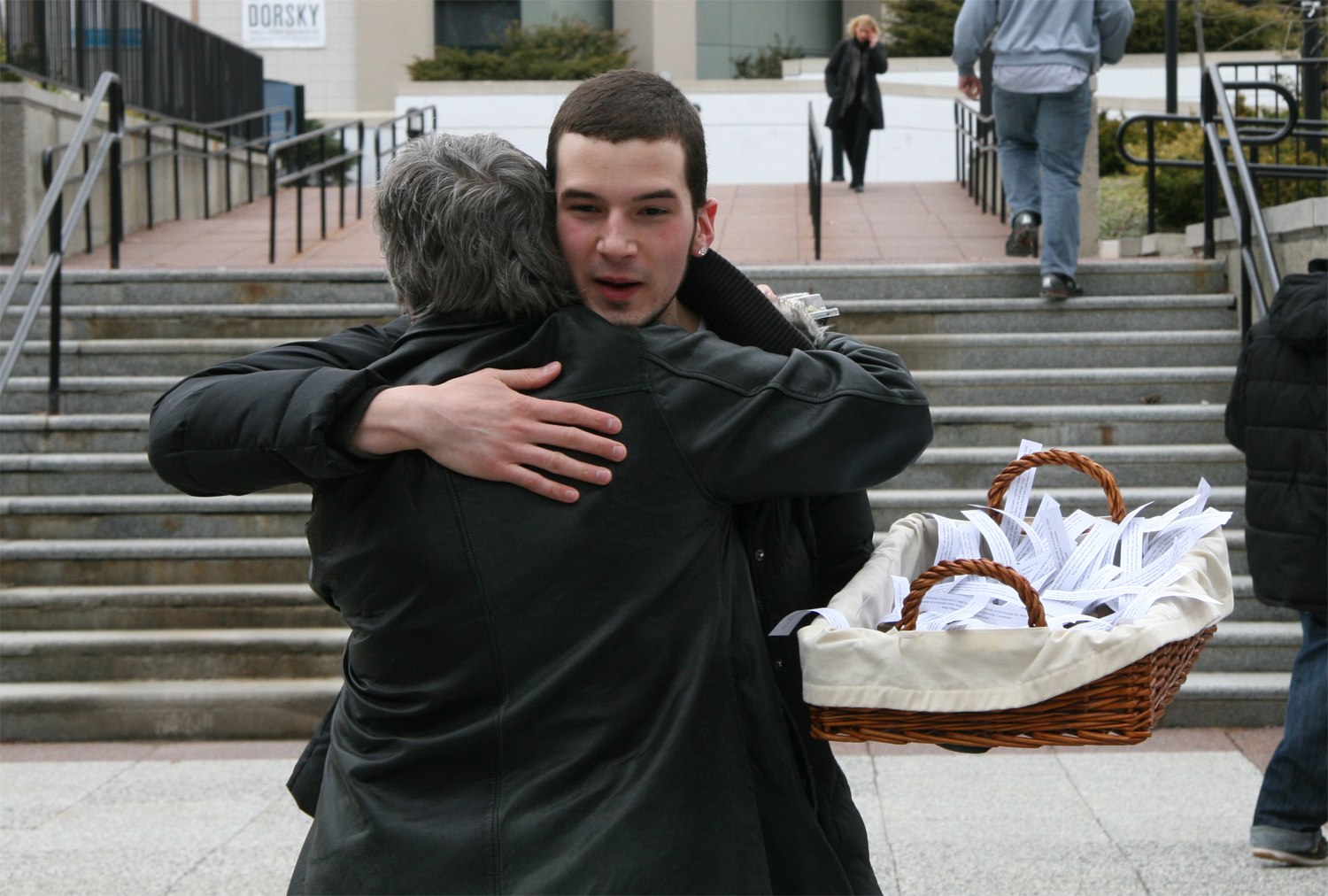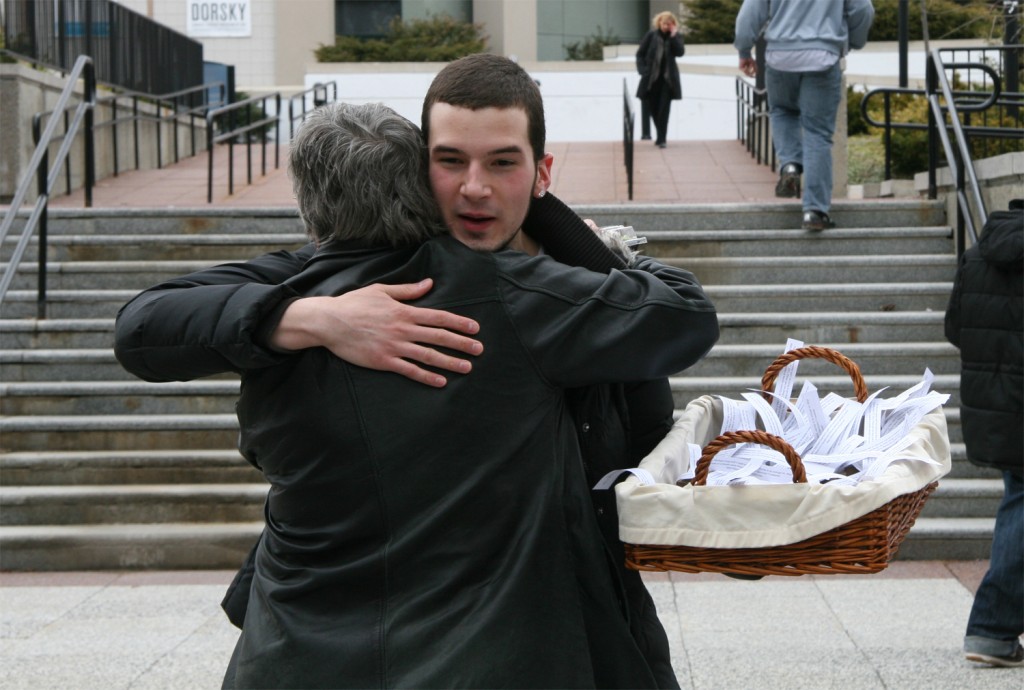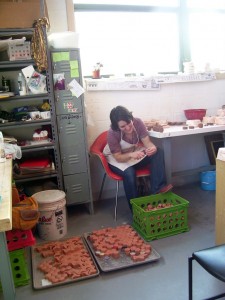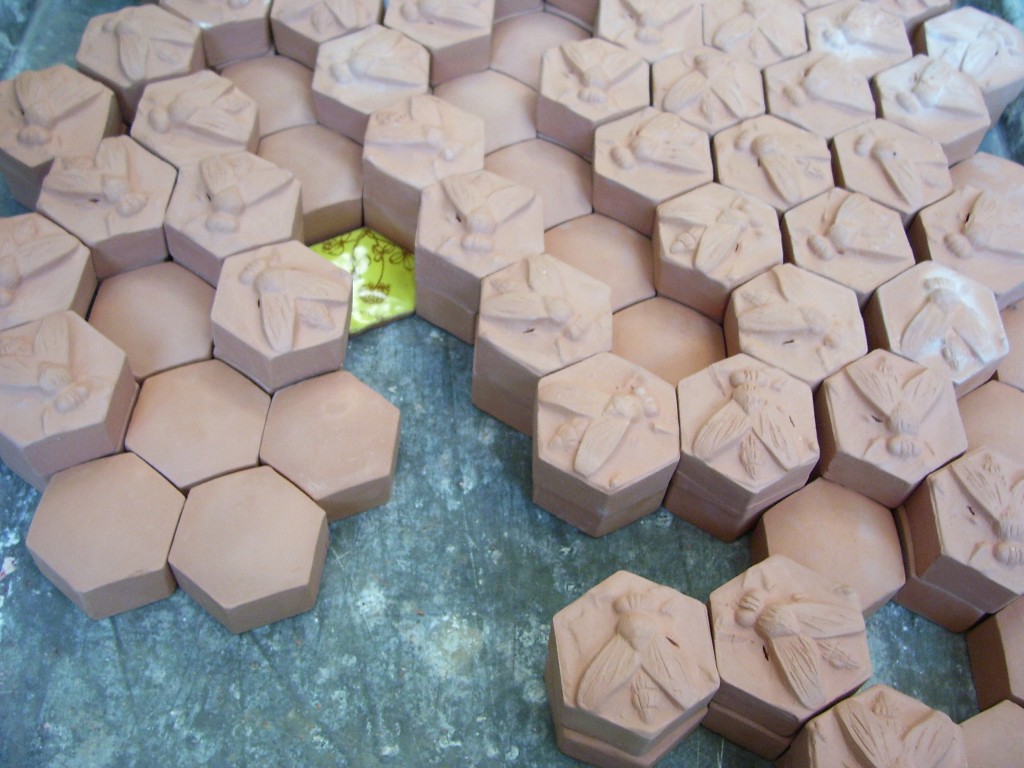

For his class Ceramic Objects as Multiples, second-year transfer BFA student Daniel Sangiacomo and his classmates were assigned to create 100 small ceramic objects and install them in a space.
Sangiacomo chose to install the art of hugging.
After deciding to make 100 “hug monsters,” representational ceramic figures of people with their arms out, Sangiacomo distributed 33 of the personified “monsters” in the lobby of the Sojourner Truth Library and 67 in the Atrium. Inspired by the “small word experiment,” Sangiacomo attached a note to the hug monster, which asked strangers to give each figure to a person “(with a hug!)” most likely to know somebody in the Ceramic Objects as Multiples class by March 17, the day of the installation.
“The art was the passing and the interaction between people,” said Sangiacomo. “The object was required but it wasn’t the focus. So by installing in the social space, the objective of the project was to create ceramic objects as a tool for positive social change.”
Out of 100 hug monsters, 17 hug monsters made it back to home base on March 17.
“If you think about it, most people that I spoke to, the hug monster passed through about three people. So, I’m responsible for like 45 hugs,” said Sangiacomo. “I really wanted the project to be fun so that people would interact with it so that people could commit to the project or involve themselves in the project. The objective was to put more hugs in the world, to be the reason that people hugged each other that day.”
Second-year student Alexis Tellefsen, who is in the class, said a stranger gave her a hug monster while she was installing her own piece in front of the library. When the stranger asked her if she was a ceramics student, she thought he was going to ask her about the ceramic levels she was placing in the grass. Instead he presented her with a hug monster.
“I couldn’t help but giggle because I didn’t have much faith in the general public to take the effort to return the monsters to ceramics students and he seemed to be equally happy to participate in Dani’s piece,” she said. “So I took the hug monster and he offered me a hug ‘to make it legit’ and went on his way.”
Tellefsen said she was really excited about being given a hug monster.
“I think that being hugged by a stranger is a unique experience on its own. There is nothing ordinary about being given a ceramic monster and getting a warm embrace from someone who’s name you don’t even know.”
Sangiacomo said a lot of his inspiration for the project came from MFA student Ruth Burket, who is working on her senior thesis and using ceramics in an effort to influence some type of social change.
For his next project, Sangiacomo will be using action ceramics to spread awareness of the herpes virus. With a ceramic rendition of the herpes virus, Sangiacomo aims to interact with people and destroy the negative connotations with herpes by “handing out the herpes virus.”
“Genital herpes, the virus affects the same way and is more than half similar to oral herpes or cold sores or fever blisters which I guess in today’s society, there’s not as much as a stigma attached to cold sores. But genital herpes, there is a lot,” he said.
The objective of his next project is to deconstruct the social stigma and misconceptions attached to genital herpes, something he believes is just “a manageable skin rash.”
“I am going to be giving out ceramic necklaces that are extremely beautiful,” he said. “I am going to encourage them to wear the necklace because herpes is not something to be ashamed of. It’s something that you can wear, you can have, you can tell people and it’s not a problem.”
Aside from encouraging people to wear the “herpes” necklace, Sangiacomo also hopes to influence dialogue and interact with the people that participate in his project.
“I hope to draw [people] in with this beautiful object and through this beautiful object, I can educate them and deconstruct the social stigma attached to herpes and include educational material in a very cohesive way,” he said.
Sangiacomo will begin his next project at the end of this semester in front of the Lecture Center. For more information about Sangiacomo’s art, go to danielsangiacomo.blogspot.com.
———————————————————————————————————————————————————-
RUTH BURKETT, MFA GRADUATE STUDENT
After a year of research for her senior thesis, MFA graduate student Ruth Burket found that feelings of insignificance and shock lead people to refrain from social action. Using pollination as the metaphor, Burket aims to depict how people’s actions can influence growth.
“I started to think, how could we address difficult social issues in a positive way, in a way that doesn’t necessarily shock people? Because at least in my case when I’m shocked or overwhelmed, it just makes me want to walk away and feel like I can’t do anything,” she said. “So I was like what is it that motivates people to do action, to do something about the problems in the world?”
Burket will begin the installation of her thesis on April 25 by giving tiles she created to a few of her friends. Inside will be a word of encouragement and instructions on what to do next. The tiles’ final destination will be in front of the Sojourner Truth Library where Burket will be during specific hours every day until May 20. After 500 tiles, Burket said the individual tiles will function like pixels to form a larger image so that individuals can visually see the significance of their actions.
“Each one of these tiles for me represents that it’s kind of small and it doesn’t seem like much when it’s by itself. The idea is that it seems insignificant but the cumulative effect of all of our insignificant actions and words is actually monumental,” she said. “Our words are kind of like this pollination that is encouraging growth and the spreading of something good and beautiful.”
By the end of the installation, Burket said she hopes to inspire dialogues about issues and what motivates people to engage in action or activism.
The social art project relies on the people’s involvement for its success. In order to get involved, participants must get in contact with Burket or go to cumulousprojects.com to find out what to do next.


